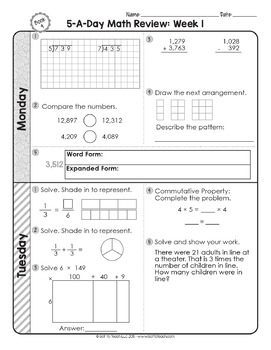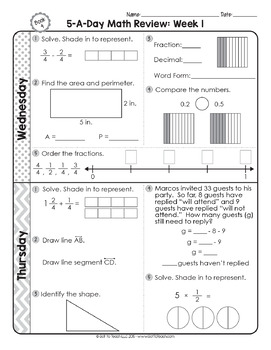- PDF
Description
Daily Math Review: This spiral review is one of the easiest ways to make sure you are covering all of the important math concepts that your students need to know. Perfect for morning work, “bell-ringers,” homework, center work, or test prep. This resource is designed to be used on a daily basis (Monday-Thursday).
Skills Covered:
•Compare Numbers (4.NBT.2) & Round Numbers (4.NBT.3)
•Add & Subtract Multi-Digit Numbers (4.NBT.4) & Concepts of Place Value (4.NBT.1)
•Generate & Analyze Patterns (4.0A.5)
•Word Form/Expanded Form (4.NBT.2) & Convert Units (4.MD.1)
•Equivalent Fractions (4.NF.1)
•Add & Subtract Fractions (4.N.F.3.A-B)
•Multiplication- Area Models & Standard Algorithm (4.NBT.5)
•Properties of Multiplication (4.NBT.5)
•Multiplicative Comparisons (4.OA.2)
•Area & Perimeter (4.MD.3) & Symmetry (4.G.3)
•Decimals & Equivalent Fractions (4.N.F.5-6)
•Comparing Decimals (4.N.F.7)
•Order Fractions (4.N.F.2)
•Add & Subtract Mixed Numbers (4.N.F.3.C)
•Lines (4.G.1) & Angles (4.MD.5-7)
•Classify Two-Dimensional Figures (4.G.2)
•Multistep Word Problems & Interpret Remainders (4.OA.3)
•Multiply a Fraction by a Whole Number (4.NF.4.A-B)
★Get The Full 36-Week Resource HERE!★
Get all the latest Teacher Thrive news!
➜FOLLOW me on Teachers Pay Teachers!
➜FOLLOW me on TeacherThrive.com!
Please read: This is a nonrefundable digital download. Please read the description carefully and examine the preview file before purchasing.
© Copyright 2018 M. Tallman. All rights reserved. Permission is granted to copy pages specifically designed for student or teacher use by the original purchaser or licensee. This is intended to be used by one teacher unless additional licenses have been purchased. The reproduction of any other part of this product is strictly prohibited. Copying any part of this product and placing it on the Internet in any form (even a personal/classroom website) is strictly forbidden. Doing so makes it possible for an Internet search to make the document available on the Internet, free of charge, and is a violation of the Digital Millennium Copyright Act (DMCA).





